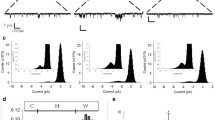Abstract
The ATP‐sensitive potassium (KATP) channel is thought to play an important role in the protection of heart and brain against tissue hypoxia. The genetic regulation of the components of the channel by hypoxia has not been previously described. Here, we investigated the regulation of the two pore‐forming channel proteins, Kir6.1 and Kir6.2, in response to hypoxia in vivo and in vitro. We find that these two structurally‐related inwardly-rectifying potassium channel proteins are reciprocally regulated by hypoxia in vivo, with upregulation of Kir6.1 and down‐regulation of Kir6.2, thereby resulting in a significant change in the composition of the channel complex in response to hypoxia. In vitro we describe neuronal and cardiac cell lines in which Kir6.1 is up‐regulated by hypoxia, demonstrating that Kir6.1 is a hypoxia‐inducible gene. We conclude that the heart and brain display genetic plasticity in response to hypoxic stress through specific genetic reprograming of cytoprotective channel genes.
Similar content being viewed by others
References
Bunn F, Poyton RO: Oxygen sensing and molecular adaptation to hypoxia. Physiol Rev 76: 839–885, 1996
Levy AP: Regulation of gene expression by hypoxia. In: N. Sperelakis, Y. Kurachi, A. Terzic, M.V. Cohen (eds). Heart Physiology and Pathophysiology, 4th edn. Academic Press, San Diego, 2001, pp 1225–1233
Acker H: Cellular oxygen sensors. Ann NY Acad Sci 718: 3–10, 1994
Wang GL, Semenza GL: General involvement of hypoxia-inducible factor 1 in transcriptional response to hypoxia. Proc Natl Acad Sci USA 90: 4304–4308, 1993
Noma A: ATP regulated K channels in cardiac muscle. Nature 305: 147–148, 1983
Dzeja PP, Terzic A: Phosphotransfer reactions in the regulation of ATPsensitive K channels. FASEB J 12: 523–529, 1998
Jovanovic A, Jovanovic S, Carrasco AJ, Terzic A: Acquired resistance of a mammalian cell line to hypoxia-reoxygenation through cotransfection of Kir6.2 and SUR1 clones. Lab Invest 78: 1101–1107, 1998
Jovanovic N, Jovanovic S, Jovanovic A, Terzic A: Gene delivery of Kir6.2/SUR2A in conjunction with pinacidil handles intracellular Ca homeostasis under metabolic stress. FASEB J 13: 923–929, 1999
Inagaki N, Gonoi T, Clement JP, Namba N, Inazawa J, Gonzalez G, Aguilar-Bryan L, Seino S, Bryan J: A family of sulfonylurea receptors determines the pharmacological properties of ATP-sensitive K channels. Science 270: 1166–1170, 1995
Inagaki N, Tsuura Y, Namba N, Masuda K, Gonoi T, Horie M, Seino Y, Mizuta M, Seino S: Cloning and functional characterization of a novel ATP-sensitive potassium channel ubiquitously expressed in rat tissues, including pancreatic islets, pituitary, skeletal muscle and heart. J Biol Chem 270: 5691–5694, 1995
Seino S: ATP sensitive potassium channels: A model of heteromultimeric potassium channel/receptor assemblies. Annu Rev Physiol 61: 337–362, 1999
Clement JP, Kunjilwar K, Gonzalez G, Schwanstecher M, Panten U, Aguilar-Bryan L, Bryan J: Association and stoichiometry of K(ATP) channel subunits. Neuron 18: 827–838, 1997
Lorenz E, Alekseev AE, Krapivinsky G, Carrasco AJ, Clapham DE, Terzic A: Evidence for direct physical association between a K channel (Kir6.2) and an ATP binding cassette protein (SUR1) which affects cellular distribution and kinetic behavior of an ATP-sensitive K channel. Mol Cell Biol 18: 1652–1659, 1998
Akao M, Sakurai T, Horie M, Otani H, Takanao M, Kouchi I, Murakami T, Sasayama S: Angiotensin II type I receptor blockade abolishes specific K(ATP) channel gene expression in rats with myocardial ischemia. J Mol Cell Cardiol 32: 2239–2247, 2000
Sgard F, Faure C, Drieu la Rochelle C, Graham D, O'Connor SE, Jania P, Besnard F: Regulation of ATP-sensitive potassium channel mRNA expression in rat kidney following ischemic injury. Biochem Biophys Res Commun 269: 618–622, 2000
Avivi A, Resnick MB, Nevo E, Joel A, Levy AP: Adaptive hypoxic tolerance in the subterranean mole rat Spalax ehrenbergi: The role of vascular endothelial growth factor. FEBS Lett 452/3: 133–140, 1999
Repunte VP, Nakamura H, Fujita A, Horio Y, Findlya I, Pott L, Kurachi Y: Extracellular links in Kir subunits control the unitary conductance of SUR/Kir6.0 ion channels. EMBO J 18: 3317–3324, 1999
Levy AP, Levy NS, Loscalzo J, Calderone A, Takahashi N, Yeo K, Koren G, Colucci WS, Goldberg MA: Regulation of vascular endothelial growth factor in cardiac myocytes. Circ Res 76: 758–766, 1995.
Ammala C, Moorhouse A, Gribble F, Ashfield R, Proks P, Smith PA, Sakura H, Coles B, Ashcroft SJ, Ashcroft FM: Promiscuous coupling between the sulphonylurea receptor and inwardly rectifying potassium channels. Nature 379: 545–548, 1996
Author information
Authors and Affiliations
Corresponding author
Rights and permissions
About this article
Cite this article
Melamed‐Frank, M., Terzic, A., Carrasco, A.J. et al. Reciprocal regulation of expression of pore‐forming KATP channel genes by hypoxia. Mol Cell Biochem 225, 145–150 (2001). https://doi.org/10.1023/A:1012286624993
Issue Date:
DOI: https://doi.org/10.1023/A:1012286624993




